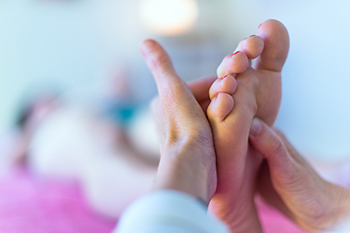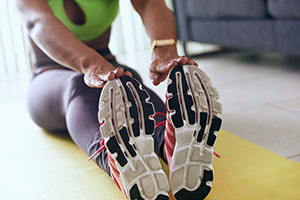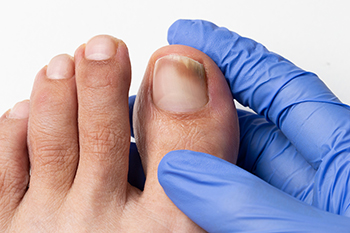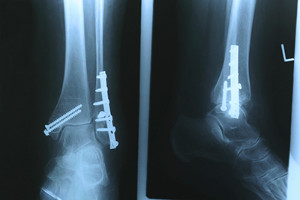

A corn is a skin lesion, usually caused by excess friction that comes from wearing shoes and socks that are too tight. It is defined as a small, hardened area of skin that can be quite painful. A hard corn generally develops on top of the toes, or on the side of the pinky toe. Additionally, they may form on the top of a hammertoe or bunion. Corns that form between the toes are referred to as soft corns, and stay moist from the sweat that accumulates there. Effective prevention methods can include wearing shoes that fit correctly, and some patients find it helpful to separate the toes by using lamb’s wool or moleskin. It may be beneficial for people who are prone to developing soft corns to purchase larger shoes that may help to keep the toes apart. Corns can develop in patients who frequently wear high heels, a result of having limited space for the toes to move. If you have a corn on your foot, it is suggested that you speak with a podiatrist who can effectively treat this ailment.
If you have any concerns regarding your feet and ankles, contact Dale Delaney, DPM of InStride Kinston Podiatry Center. Our doctor will treat your foot and ankle needs.
Corns: What Are They? and How Do You Get Rid of Them?
Corns can be described as areas of the skin that have thickened to the point of becoming painful or irritating. They are often layers and layers of the skin that have become dry and rough, and are normally smaller than calluses.
Ways to Prevent Corns
There are many ways to get rid of painful corns such as wearing:
Treating Corns
Treatment of corns involves removing the dead skin that has built up in the specific area of the foot. Consult with Our doctor to determine the best treatment option for your case of corns.
If you have any questions please feel free to contact our office located in Kinston, NC . We offer the newest diagnostic and treatment technologies for all your foot and ankle needs.

We all have sore feet from time to time. After all, our feet do a lot of work for us and put in long hours. There are a variety of ways to soothe sore feet at home. Generally, using a combination of treatments work best to revitalize sore feet. Warm foot baths using Epsom salts can relieve swollen, painful feet. Stretching the toes and heels can aid with foot pain by increasing flexibility and preventing cramping. Foot pain can be avoided by strengthening and resistance exercises to help keep feet strong and limber. Orthotics or arch supports can help stabilize the feet and eliminate discomfort. Simple icing of aching feet can reduce inflammation that may be caused by soreness. Wearing night splints can help with keeping feet stretched properly to avoid or control foot pain. If you have painful, achy feet or tingling or numbness in your feet, a podiatrist should be consulted and treatment prescribed.
Foot therapy is often necessary for those recovering from either foot deformities or foot injuries. If you have concerns regarding therapy, consult with Dale Delaney, DPM from InStride Kinston Podiatry Center. Our doctor can provide the care you need to keep you pain-free and on your feet.
Most Common Injuries
People who are active or athletes are prone to a variety of injuries. Therefore, it is often important to take part in physical therapy in order to quickly get back on the right track.
What to Do When Injured
Physical Therapy – This specialized treatment will focus on the affected area, speeding up recovery and the overall healing process. It is a proven method that has helped millions of people return from any injury.
During physical therapy you will undergo regimented training to get back into full form. Training is often very difficult, especially at first when the foot feels weak. Physical therapy often involves:
Basic stretching and twisting exercises – getting the feet’s mobility and flexibility up.
Massaging – the therapist will massage the injured area in order to activate the muscles and relax them.
Strengthening Exercises – this allows the muscles in the affected area to regain their full strength, a vital step towards full recovery.
If you have any questions please feel free to contact our office located in Kinston, NC . We offer the newest diagnostic tools and technology to treat your foot and ankle needs.

There are many people who have busy schedules which can make it difficult to practice adequate warm up and cool down stretches before running. It is important to make time to properly stretch before and after running, as this may help to prevent running injuries. Beneficial changes that can help to avoid injuries consist of improving form by maintaining good posture, and practicing correct training procedures. Research has shown it helps to gradually increase mileage and speed, and it is important to stay hydrated and to eat enough protein. Additionally, when one day per week is taken off from running, it can help to give the body adequate time to rest. If you have questions about how running injuries can affect the feet and how to avoid them, please consult with a podiatrist.
All runners should take extra precaution when trying to avoid injury. If you have any concerns about your feet, contact Dale Delaney, DPM of InStride Kinston Podiatry Center. Our doctor will treat your foot and ankle needs.
How to Prevent Running Injuries
There are a lot of mistakes a runner can make prior to a workout that can induce injury. A lot of athletes tend to overstretch before running, instead of saving those workouts for a post-run routine. Deep lunges and hand-to-toe hamstring pulls should be performed after a workout instead of during a warmup. Another common mistake is jumping into an intense routine before your body is physically prepared for it. You should try to ease your way into long-distance running instead of forcing yourself to rush into it.
More Tips for Preventing Injury
If you have any questions, please feel free to contact our office located in Kinston, NC . We offer the newest diagnostic and treatment technologies for all your foot care needs.

A fungal infection of the toenails is medically referred to as onychomycosis. It can be unsightly as a result of the toenails becoming thick and yellowed, which are common symptoms of toenail fungus. It is considered to be a contagious infection and lives and thrives in warm and moist environments. These types of places can include public swimming pools, shower room floors, and locker rooms. It is advised to wear appropriate shoes while in these areas, in addition to refraining from sharing towels, shoes, and socks. These may be effective prevention methods, but it is also suggested to frequently wash and thoroughly dry the feet, as well as practice overall good hygiene. Toenail fungus can be difficult to treat and may take several months. If you have symptoms of this condition, it is strongly advised that you consult with a podiatrist who can determine the best treatment options for you.
For more information about treatment, contact Dale Delaney, DPM of InStride Kinston Podiatry Center. Our doctor can provide the care you need to keep you pain-free and on your feet.
Toenail Fungus Treatment
Toenail fungus is a condition that affects many people and can be especially hard to get rid of. Fortunately, there are several methods to go about treating and avoiding it.
Antifungals & Deterrence
Oral antifungal medicine has been shown to be effective in many cases. It is important to consult with a podiatrist to determine the proper regiment for you, or potentially explore other options.
Applying foot powder on the feet and shoes helps keep the feet free of moisture and sweat.
Sandals or open toed shoes – Wearing these will allow air movement and help keep feet dry. They also expose your feet to light, which fungus cannot tolerate. Socks with moisture wicking material also help as well.
If you have any questions please feel free to contact our office located in Kinston, NC . We offer the newest diagnostic tools and technology to treat your foot and ankle needs.

Stress fractures are bone breaks that happen more subtly than one would usually think of when imagining broken bones. They are caused by repetitive movement on or by a bone over time. These fractures can either be hairline fractures or total breaks. Common areas of the body for stress fractures to occur include the shin, thigh, pelvis, and feet. Anyone can be affected by stress fractures but they are most commonly seen in athletes, healthcare workers, and military personnel. Generally, this type of fracture is caused by overuse. While the body is constantly repairing itself, certain actions prevent the body from normal healing. Feet need ample time to rest and repair or one can be prone to fractures. Other possible causes of bone breaks include osteoporosis, wearing improper footwear (too tight, too high, or not supportive), misaligned bones or muscles, obesity, and using oral steroids. If you experience foot pain that is not going away in a reasonable time frame, visit a podiatrist to see if you have developed a stress fracture.
Activities where too much pressure is put on the feet can cause stress fractures. To learn more, contact Dale Delaney, DPM from InStride Kinston Podiatry Center. Our doctor can provide the care you need to keep your pain free and on your feet.
Dealing with Stress Fractures of the Foot and Ankle
Stress fractures occur in the foot and ankle when muscles in these areas weaken from too much or too little use. The feet and ankles then lose support when walking or running from the impact of the ground. Since there is no protection, the bones receive the full impact of each step. Stress on the feet can cause cracks to form in the bones, thus creating stress fractures.
What Are Stress Fractures?
Stress fractures occur frequently in individuals whose daily activities cause great impact on the feet and ankles. Stress factors are most common among:
Symptoms
Pain from the fractures occur in the area of the fractures and can be constant or intermittent. It will often cause sharp or dull pain with swelling and tenderness. Engaging in any kind of activity which involves high impact will aggravate pain.
If you have any questions please feel free to contact our office located in Kinston, NC . We offer the newest diagnostic and treatment technologies for all your foot and ankle needs.